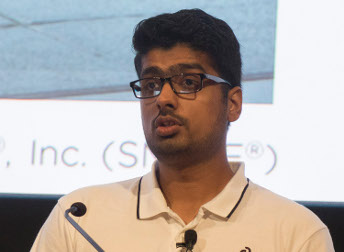Color Management: Is What You See What You Get?
Chaired by Arjun Ramamurthy of 20th Century Fox, Tuesday morning's color management sessions examined some of the challenges content creators will face, both from technical and creative perspectives, as they make use of the availability of a wider color gamut and high dynamic range.
Because this technology allows significant increases in the amount of usable visual information, it also presents new ways for that pipeline, from camera through mastering to display, to go wrong.

Syed Waqas Zamir Syed Waqas Zamir presented research he recently completed, along with Javier Vazquez-Corral and Marcelo Bertaimío, all of Universitat Pompeu Fabra, Barcelona, Spain. Their paper, "Perceptually-based Gamut Extension Algorithm for Emerging Wide Color Gamut Display and Projection Technologies," details issues involved in developing an efficient Gamut Extension Algorithm (GEA) that would optimize image data mastered for a more constrained gamut, making the most of a display using a higher gamut.
In the presentation, Zamir defined the characteristics such an algorithm would require, which would naturally involve a representation as perceptually faithful to the master as possible and a minimal amount of hue shifting and artifacts. For it to be practical, it should be applicable to gamut differences as large as those between BT.709 and BT.2020.
Zamir also placed the work he and his colleagues did into perspective by presenting some history of previously developed algorithms–Same Drive Signal (SDS), Hybrid Color Mapping (HCM), Chroma Extension (CE)–and explaining the shortcomings of each, before discussing the specifics of his and his team's solutions. These solutions involved making use of a logistic function to treat objects in an image that are of low saturation and high saturation differently; the function adapts itself according to the content input image and it makes less modification to certain specific ranges, especially skin tones and sky, than others.
The presentation concluded by showing some examples of small gamut and BT.709 images transformed using the solutions Zamir and his colleagues developed for presentation in the DCI-P3 gamut.

Jack Holm Jack Holm of Tarkus Imaging USA delivered the follow-up presentation, "Adapting Content to Different Display Capabilities and Viewing Environments," which explores the extremely complex issues involved in creating a "master" for HDR when HDR displays come in many types (Do you master for 1,000 nits? 10,000?), with different capabilities and where changes in viewing environment significantly affect perception of the image to the end user.
Given these variables and a much greater color volume than previously available for consumers, Holm asked rhetorically, "What's a display to do? What's a colorist to do?" Holm first suggested some characteristics he thinks are necessary for a grading monitor to possess when the objective is to ensure as many end users as possible see an image that is as close as possible to what the creative talent sees.
It's important, he continued, for a display to clip out-of-gamut values and not accommodate them via compression: "You don't want a colorist working on any kind of dynamic dimming display," he cautioned. "There might be [an interior shot] with a bright window. If the colorist looks at a display with dynamic dimming, they might leave the window as it is because it's not distracting from the main action. But then if someone looks at it on a monitor that doesn't have that feature, the window could come up far too bright!"
Holm was dismissive of the concept of "gamut mapping," which, he said "is something I've been hearing about since I got into color science in the '80s. But the CIE [Commission Internationale de L'Ecairage] decided there is no single solution to this. It is ultimately a creative choice."
An end-user display shouldn't do more than necessary to an image, Holm said. Instead, it should be able, through the use of metadata, to recreate what was done in mastering. Display manufacturers, he noted, "may want to make it look particularly 'wonderful' in the store, but you really don't get rewards for making the image look 'better' than the master."
Get the TV Tech Newsletter
The professional video industry's #1 source for news, trends and product and tech information. Sign up below.
